On high alert to meet civic emergencies with motto ‘We Serve to Save’
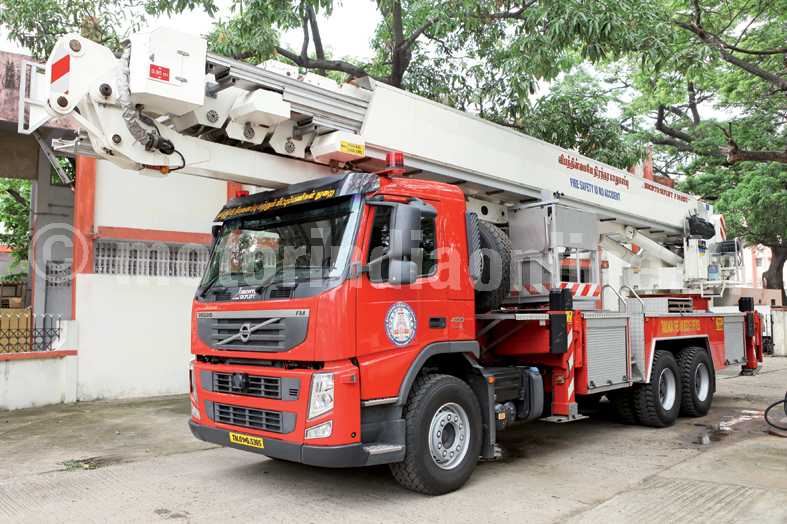
“It was a frantic call at about 7.30 a.m. on 3rd Oct. 2012 for an emergency rescue operation in a collapsed three storied building. An old building located in one of those labyrinth lanes of the congested city area, Triplicane, Chennai had come down like a deck of cards – it was a disaster waiting to happen and our personnel rushed to the spot with rescue tenders and specialised equipment. Fortunately there were not many occupants at the time of collapse, many having vacated earlier taking warning bells of cracks appearing in the dilapidated building; and using sniffer dogs to trace trapped persons, the team swung into action. One woman and her son were brought out of the rubble alive with minor injuries after hours of strenuous effort using hydraulic spreaders, cutters et. al., and casualty restricted to two persons. The very sight of two persons being brought out alive drew loud cheers from crowd that had gathered to witness the actions – a proud moment indeed for the rescue team. Firemen who took part in the rescue effort were awarded President’s Fire service medal for gallantry”, recalls Mr. S. Vijayasekar, Deputy Director (Northern Region), Tamil Nadu Fire and Rescue Services (TNFRS), during interactions at his Chennai office.
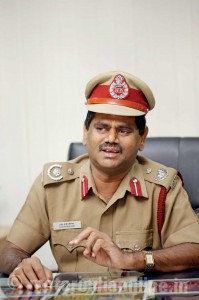
He adds: “Primary functions of TNFRS are fire-fighting, prevention and rescue activities. The secondary functions include providing standby bandobast arrangements during fairs, festivals, various other religious gatherings and political meetings. During times of emergencies be it fires, road accidents or floods, the first responder is TNFRS; people rush out of buildings on fire and we move inside to fight the blaze, fully aware of discernible and lurking dangers during the exercises – it is part and parcel of the chosen profession. The main task of fire fighters is to save people and their belongings in any calamity either natural or man-made.”
“Genesis of the organisation dates back to 1908; it was started as City Fire Brigade Services, a year after a major fire in the commissioner of revenue administration, land record office that destroyed all records and maps. The administrative functions came under Madras Corporation and operations under Police dept. The organisation was based on British pattern and the real fillip came during 1942 at the time of 2nd World War. Also the major fire in London during that period resulted in the dept. getting streamlined and various service stations were set up initially all along the railway track – to put out fires due to spontaneous combustion in coal yard, a major concern at that time. Formal training was also provided by British Officers to the Fire Brigades. It was during 1967 that a separate department for Fire Services created and all operations brought under it”, briefs Mr. Vijayasekar commenting on the early days of organisation. TNFRS is currently the 2nd largest in the country after the one in U.P., having 302 Fire stations spread all over the State and 2 Rescue stations, one at Hogenekal and other at Kotagiri. Basic unit of fire service is a Fire station; and Single unit Fire station comprises 2 or 3 standard vehicles, 17 support personnel and multiples thereof for higher end stations; for special vehicles, more personnel are tagged for operations. Rescue services were brought under the organisation formally in 2002 and the new name evolved as it is known today, says Mr. Vijayasekar.
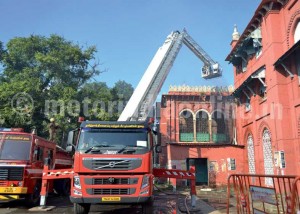
The Fire fighting vehicles conform to type B model of Bureau of Indian Standards specifications. Basic Fire tender is on 1612 chassis having water tank of capacity 4500 ltr. TNFRS procures chassis of Ashok Leyland, Tata and other makes, hands it over to Cheran Transport Corporation, a State Govt. undertaking for body building and fabrication work. Centrifugal pump, hoses, nozzles, downpipes and miscellaneous fitments are separately procured and given to the body builder for integration in the vehicle; and complete unit as per specifications upon delivery handed over to the dept. for inclusion in service. Similarly other vehicles in the fleet like Foam tender and Emergency rescue tender are inducted. Current range of standard vehicles in the fleet includes Water tender-326 nos., Small foam tender-80 nos., Emergency rescue tender-5 nos., Hydraulic platform, Simon Snorkel make-1 no., Turn table ladder Isuzu Morita make-1 no., Hydraulic platform cum turn table ladder Volvo Bronto make-3 nos., Hose laying tender-1 no. and various others like Water tenders, Portable water pumps, Mechanised fibre boats, Rescue equipment, Protective equipment and Electronic gadgetry. Typical Water tender has centrifugal pump driven by PTO of the vehicle engine and dual pressure/volume settings – 1800 to 2200 lpm at 7 to 8 Kg/sq.cm. and 350 lpm at 30 Kg/sq.cm.
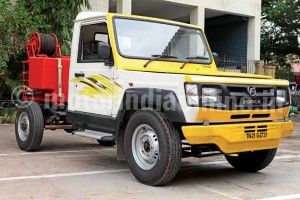
“Most of the commonly encountered fires can be put out by Water tender and in case of oil fire, Foam tender has to be deployed. In the Foam tender, two separate tanks are provided, one for foam and other for water; the two are mixed up in required proportion by venturi principle to deliver foam at the target spot. Emergency rescue tender is similar to the normal Fire tender but has additional lockers to carry rescue equipment like hydraulic spreaders, cutters, rock breakers, jacks, pneumatic tools and power packs. We have also introduced Motorbike Fire tenders and Mini Fire tenders that utilise ‘water mist technology’ to fight the fire; manoeuvrability and speed enable these small units reach the fire spots fast, especially thro’ congested areas of cities – to fight the fire till such a time the main units arrive. The fire hazard issues can be thus effectively addressed by having combination of these units placed at various strategic locations in populous cities and towns”, opines Mr. Vijayasekar.
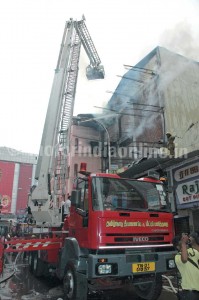
“Rapid urbanisation poses problems of different dimensions. Erstwhile horizontal buildings layout is now transforming into vertical construction pattern going up to 120 mtr and more – as per new rules, approval for buildings to go up to 200 mtr has been given. To tackle fires and rescue operations in the changed circumstances, we need to deploy special vehicles; Hydraulic platforms, Bronto Finland make with Volvo chassis that can reach up to 54 mtr and Turn table Ladder of Isuzu Morito that can be deployed for access up to 43 mtr are in use. We have plans to procure 2 nos. 104 mtr hydraulic platform to supplement the fleet. Beyond this reach, because of high wind speeds and other factors, we may have to depend on dedicated fire fighting systems provided in the building to meet the hazard”, indicates Mr. Vijayasekar.
Recalling a few cases Mr. Vijayasekar says: “It was an instance of service technicians getting stranded at a height of 170 ft while attending to high mast floodlight repair work in MAC cricket stadium, Chennai. The cable operated make shift lift got stuck and for over 8 hrs they were holed up at that height. We used the hydraulic platform to reach up to 140 feet; and to reach the technicians use additional ladders fixing it on to the platform. Strong sea breeze made the rescue task difficult and the persons were brought down with great difficulty after making three attempts. In another case of fire in a textile showroom, fire in second floor forced people to rush to the terrace. We had to fight the fire on one hand and parallely reach up to the panicking people in terrace thro’ Turn table ladder and bring them down to safety. In the case of fire accidents in multi-storey buildings that is on the rise these days, use of many vehicles both standard and special types are becoming a necessity to fight fire and rescue people. There was also the case when a cracker-laden truck got stuck in an road underbridge (rail tracks over) near Coimbatore railway station. The truck could not go thro’ because of excess payload height and exploded upon impact. Cracker fire/bursting, ruled out getting rescue equipment anywhere close to the truck inferno; and a train was approaching the underbridge. One of our officers took the timely yet risky action; he went thro’ the fire and cut binding ropes holding cracker load to the truck body. Payload collapsed on ground and the truck could be taken out in time before causing damages to the train passing over”. It’s always the combination of man-machine that helps in overcoming a crisis situation and in this regard, the training given to our personnel assumes a paramount importance, remarks Mr. Vijayasekar.
TNFRS has a dedicated state-of-the-art training centre at Tambaram, Chennai, for training new recruits and as well existing personnel in upgrading their knowledge and skills thro’ refresher courses. National Fire Service College (NFSC), Nagpur, a Govt. of India organisation coming under the Ministry of Home Affairs has approved Chennai centre for certain special training courses. The training sessions typically consist of both classroom and field training exercises. Advanced level courses/training, especially to the senior personnel, are provided by NFSC; also thro’ NFSC, Fire personnel of all the States are linked for interactions and exchange of domain specific knowledge, adds Mr. Vijayasekar. TNFRS has also a small workshop in Chennai to train its personnel for attending minor repairs connected with vehicle, PTO, pump etc., to be prepared for any site emergencies. As regards organisational structure, TNFRS is headed by the director in the rank of Director General of Police; has Joint directors, Deputy directors and Divisional officers to form the core operations team and a total of about 6700 personnel in the organisation. In line with tradition and for working efficacy, TNFRS continues to have a close working association with Police dept. as the functions of the two depts. complement each other in attending to emergency operations.
“Though ours is an emergency operations outfit, we do educate people periodically vis-à-vis safety issues by conducting mock drills especially in hospitals, schools and slum areas. One such mock drill in Kancheepuram district regarding emergency measures to be taken during the time of floods, one week prior to the Tsunami, helped the village record nil fatalities – even when the entire village got submerged in raging sea water during the calamity. Also in the immediate aftermath of Tsunami tragedy, we used helicopters for detecting people trapped and alive, dead and buried – it was a very difficult task to trace the missing people within a short period. Only after the above disaster, to detect presence of trapped/buried, we introduced the sniffer dog squad. Yes, we need to introduce technology at all levels and prepare the teams face unforeseen crises; Kedarnath catastrophe has again taught us valuable lessons – to urgently pursue and add on both in quantity and quality aspects, equipment, tools & tackles for use by trained personnel”, feels Mr. Vijayasekar.
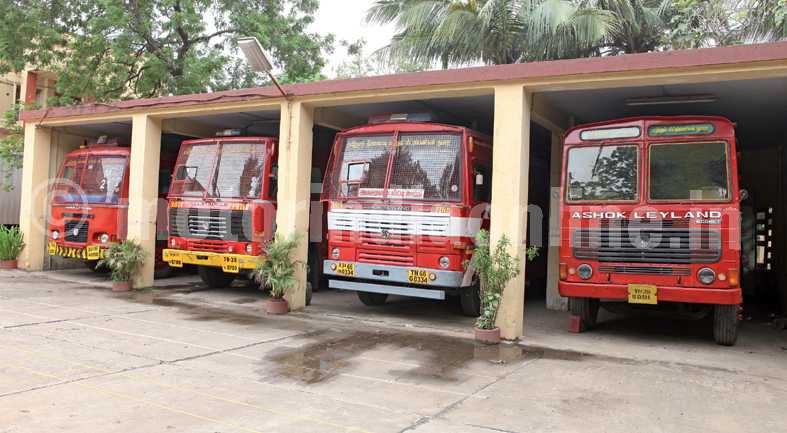
As regards the role of citizens, equally important, he says it starts right from communication of the fire or other disaster details. In the case of fire, details like the location, type of fire, approach areas, etc., would be needed so that apart from standard equipment, fire fighters also take special equipment to tackle emergencies. Fire accidents in the past were essentially in industrial and slum areas; these days it’s happening increasingly in malls, vehicles including cars, trucks, LPG autos, multi-storeyed buildings, hospitals and schools. “In fire fighting, the first 15 min are crucial for during this period fire can be put down; in the period beyond this threshold in general, focus will be on containment and hence the need to be present at the fire spot at the earliest. We aim at a response/target time of 10 min in cities, 12 to 15 min in mofussil and 15 to 20 min in village areas viz., from the time of call to action at site. To meet the response time of 10 min, we take assistance from police, corporation and water supply board besides GPS tracking thro’ control rooms. Despite the best of efforts, because of various constraints, we overshoot the targeted time response on many occasions; and hence always strive to cut down delays-in this regard, assistance from all quarters is crucial”, summarises Mr. Vijayasekar.
April 14th is an important day in the fire service calendar of India-the day being celebrated all over the country as ‘Fire Service day’ in memory of 66 firemen who lost their lives in action during the Mumbai dock fire in 1944. For a week during this period (14th-21st Apr.), TNFRS conducts intensive programs related to fire safety and prevention, audits and mock drills. Also the public is involved in basic exercises related to addressing fire hazards and simple measures to be followed in the event of calamities. “In today’s scenario our focus is on hospitals, schools and malls; schools and hospitals need special attention due to nature of inmates while in the case of malls, situation is very different. Malls which have about 1000 visitors during weekdays tend to have more than 30,000 foot falls on weekends. With no increased safety measures to cater to this type of crowd, these are always potential death traps-hence, public awareness and attention to fire safety assume paramount importance”, points out Mr. Vijayasekar.
“Despite the best of equipment and planning, uncertainties involved in fire fighting and rescue operations are always multitude; and there is always the imminent danger to lives of fire fighters during the operations. From Kargil, Kedarnath to everyday emergencies all over, we have valiant men risking their lives to perform their duties. Our firemen come in that dedicated category and yes, we are aware of the hazards but it’s the commitment to cause and motto that drives us to take risks in saving lives and destruction of property”, sums up Mr. Vijayasekar. Flipping thro’ pages of souvenir released by TNFRS to commemorate the centenary celebrations of the organisation in 2008, picture of Father of the Nation and his message catches one’s attention.
“It is the quality of our work which will please God and not the quantity. The best way to find yourself is to lose yourself in the service of others. Man becomes great exactly in the degree in which he works for the welfare of his fellowmen.”
– Mahatma Gandhi
It is indeed an apt description for the men in uniform all over and fire fighters of TNFRS can definitely feel proud in demonstrating vividly the above and ‘Be the change you want to see in the world’. Let us salute this ‘action force’ and fervently hope people assimilate the messages passed on by such a great organisation and contribute to a safer and better world.